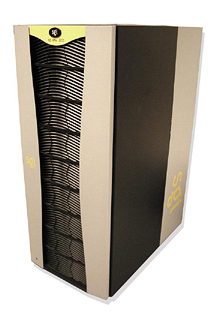 The Ohio Supercomputer Center (OSC) has chosen the SGI® Altix 3000 to replace its SGI® Origin 2000, and augment its HP Itanium 2 Cluster. The SGI Altix 3000 is a non-uniform memory access system with 32 Itanium processors and 64 gigabytes (GB) of memory. The Altix features Itanium 2 processors and runs the Linux operating system.
The Ohio Supercomputer Center (OSC) has chosen the SGI® Altix 3000 to replace its SGI® Origin 2000, and augment its HP Itanium 2 Cluster. The SGI Altix 3000 is a non-uniform memory access system with 32 Itanium processors and 64 gigabytes (GB) of memory. The Altix features Itanium 2 processors and runs the Linux operating system.
OSC's HP Cluster also includes Itanium 2 processors and runs Linux. The cluster and Altix are distinguished by the way memory is accessed and its availability to any or all processors.
"The Altix provides OSC with a large shared memory system that integrates with our existing Itanium 2 cluster infrastructure," said Troy Baer, OSC Systems Engineer. "It can handle jobs that simply won't run on any of OSC's other Itanium 2 systems - jobs that need 3-to-32 processors with a shared address space, and jobs that need more than 12 gigabytes (GB) of memory."
Since data locality isn't as much an issue on shared-memory systems as it is on distributed memory systems, it can be somewhat easier to develop parallel applications.
Also, researchers with large serial memory applications will have up to 64 GB available. This is five times more than what is available on the cluster's single node. The OSC user community will benefit from this system because it will receive continued support for NUMA architectures, access to large memory, access to OpenMP parallel environments, and access to applications that are well suited for that architecture.
"As with all high performance computing systems at OSC, the SGI® Altix will be used to enable research and enhance discovery," said Leslie Southern, OSC High Performance Computing Director.
The transition to a supported operating system and processor should also be easier and smoother for OSC users. As a result, staff support requirements will not be overextended during the transition period. In addition, OSC and SGI® , through James River Technical, have agreed to upgrade the Altix Itanium 2 processors to next generation processors when they become available in the fall.
Many existing applications can be processed with the Altix NUMA features, and researchers can simply add a parameter that requests multiple processors. For example, Gaussian is one of the applications that works well with Altix. Gaussian is an electronic structure program used by chemists, chemical engineers, biochemists, and physicists studying molecules and reactions under a wide range of conditions.
Other NUMA-enabled computational chemistry applications include NWChem from Pacific Northwest National Laboratory and the Amsterdam Density Functional (ADF) package. Two of the prominent structural mechanics applications, LS-DYNA and ABAQUS, also have shared-memory versions available. A number of Ohio engineers from academia and industry use these applications.
Workshop Offered
A one-day Altix workshop will be held on September 30 in OSC's BALE theater and taught by Baer. This course will teach users how to effectively use OSC's SGI Altix 3000 system. Users will learn to access the system, use compliers, run batch jobs, and use the Altix shared-memory parallel programming capabilities.
"The workshop will cover all the basics of how to use Altix in OSC's environment such as logging on, using development tools to build applications, and running those applications on the Altix," said Baer. "The workshop will also discuss what types of applications are right for the Altix architecture, as well as some tools for getting the best performance."